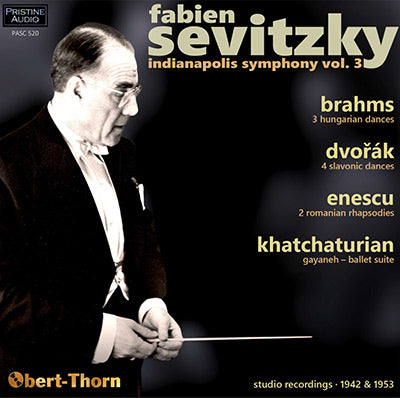
This album is included in the following sets:
This set contains the following albums:
- Producer's Note
- Full Track Listing
- Cover Art
The present release brings together several works inspired by folk dances of various European and Asian peoples, in some of the earliest and latest recordings made by the Indianapolis Symphony under Fabien Sevitzky. The Brahms disc has not been reissued since its original 78 rpm release, while the remaining recordings, first released on LP, have not been available for over half a century.
The Brahms Hungarian Dances date from 1942, a year after Sevitzky began recording in Indianapolis for the Victor label. No orchestrator credits were given on the original disc, but comparisons reveal them to be Brahms’ own transcriptions for Nos. 1 and 3 and Martin Schmeling’s transposed arrangement for No. 7, with some emendations, most likely by the conductor himself (e.g. the solo celesta ending for No. 3). The performances have a tremendous verve and swagger which seems to leap off the grooves.
Sevitzky made his final recordings for Victor in 1946, although some were not first released until 1949. In 1953, the fledgling Capitol label signed Sevitzky and the orchestra to record the Dvořák, Enescu and Khatchaturian works on our program, along with the latter’s Masquerade Suite (which will be included on a future volume in this series). Capitol’s engineering philosophy was markedly different from that which Sevitzky had been given by Victor, with the new label favoring a brilliant sound emphasizing the wider frequency range now allowed by tape-based recording, but with less depth to the bass and what sounds like the addition of artificial reverberation.
The Dvořák dances are in the same fiery vein as the Brahms from a decade earlier; while in the First Romanian Rhapsody, Sevitzky holds back the faster tempos until later than some other conductors in order to maximize their impact toward the end. For the Khatchaturian, whose score includes Armenian folk melodies and Kurdish, Georgian and Ukrainian dances, Sevitzky rearranged the order of the eight movements of the first ballet suite, which at the time had placed the ubiquitous “Sabre Dance” at the beginning.
The Capitol recordings were to be the last Sevitzky made, as he left the orchestra in 1955. He continued to teach and guest conduct until his death in 1967.
Mark Obert-Thorn
BRAHMS Hungarian Dances, WoO 1
1 No. 1 in G minor (3:41)
2 No. 3 in F major (2:34)
3 No. 7 in A major (F major for orchestral version) (1:26)
DVOŘÁK Slavonic Dances, Op. 46
4 No. 8 in G minor (3:55)
5 No. 2 in E minor (4:28)
6 No. 4 in F major (7:11)
7 No. 1 in C major (3:32)
ENESCU Romanian Rhapsodies, Op. 11
8 No. 1 in A major (11:44)
9 No. 2 in D major (10:51)
KHATCHATURIAN Gayaneh – Ballet Suite
10 Introduction and Dance of the Rose Maidens (4:44)
11 Awakening and Dance of Aysha (6:57)
12 Dance of the Mountaineers (1:39)
13 Lullaby (5:17)
14 Sabre Dance (2:28)
15 Armen’s Variation (1:51)
16 Dance of the Young Kurds (3:26)
17 Lezghinka (3:12)
Fabien Sevitzky ∙ Indianapolis Symphony Orchestra
Producer and Audio Restoration Engineer Mark Obert-Thorn
Artwork based on a photograph of Fabien Sevitzky
Brahms recorded 29 January 1942 on matrices CS 071357-1 and 071358-2. First issued on Victor 11-8223.
Dvořák, Enescu and Khatchaturian recorded on 22 – 23 January 1953 and first issued on Capitol H-8211 (Dvořák), H-8210 (Enescu) and P-8223 (Khatchaturian).
All recordings made in the Murat Theatre, Indianapolis.
Total Timing 78:57

